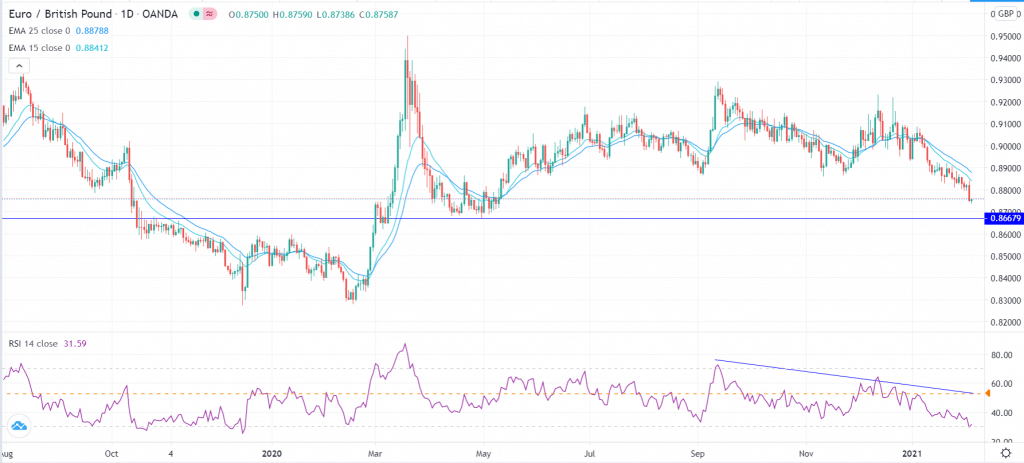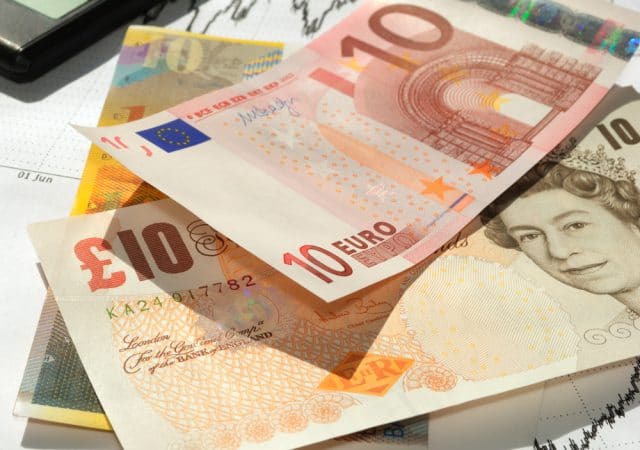The EUR/GBP price collapsed to the lowest level since May last year as traders continued to react to the interest rate decision by the Bank of England. It is trading at 0.8753, which is 7.8% below last year’s high of 0.0.9500.
Stronger sterling after BOE
The current weakness of the EUR/GBP price is mostly because of the overall strength of the British pound. Indeed, the pound index has risen to the highest level since April 2018.
This price action is happening at a difficult time for the UK. Data released this week showed that the important services segment contracted to the lowest level since April last year. This happened as the country implemented one of the toughest lockdowns to curb the spread of the new strain of the virus.
On Monday, data showed that the UK manufacturing sector also expanded at a reduced pace. Meanwhile, government spending has pushed public debt to the highest level in years. And the trend is expected to continue as the government furlough program continues.
Worse, the housing sector has also started to slow. On Friday, data by Halifax, a company owned by Lloyds Bank, showed that the house price index declined by 0.3% in January after rising by 0.2% in December. On an annualized basis, the index rose by 5.4%, a decline from the previous 6.0%.
Therefore, the EUR/GBP is falling because of the support by the Bank of England. In January, Governor Andrew Bailey warned about the difficulties of implementing negative rates in the country. He argued that the bank was still studying the implications of these rates.
In its interest rate decision this week, the central bank left interest rates and quantitative easing targets unchanged. Interestingly, these decisions were unanimous even as the bank slashed its forward guidance. Also, the governor said that there was no need for taking rates negative at this time.
Weaker euro
Meanwhile, the EUR/GBP has also declined because of the overall weaker euro. The euro index had dropped to the lowest level since November last year. In fact, data in the options market shows that the trend will continue.
Like the UK, data from the European Union has been weak. On Thursday, data showed that the bloc’s retail sales grew at a slower rate in December. Also, the services PMI declined in January because of the lockdowns. Most importantly, the bloc’s inflation remains substantially below the target of the European Central Bank (ECB).
As a result, some ECB members have already started promoting the idea of another rate cut. Last week, Klaas Knot, a member of the monetary policy committee, suggested that the bank could adjust the deposit facility rate to support the recovery. This would push interest rates to the lowest level on record even as it implements a large quantitative easing program.
Also, there are concerns about the bloc’s vaccination issues. While the regulators have already accepted the vaccines by Moderna and Pfizer, the pace of administering them has been relatively slow.
EUR/GBP technical outlook
On the weekly chart, we see that the EUR/GBP has been in a sharp downward trend in the past few weeks. As a result, the pair has managed to move below the 25-week and 15-week exponential moving averages while the Relative Strength Index (RSI) has continued to fall. The price is also below the Ichimoku cloud. Therefore, in the near term, the pair will likely continue falling as bears target the next support at 0.8667, which is the lowest level in May 2020.





